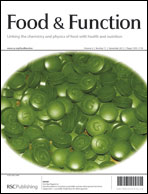Oxidative stability and chemical safety of mayonnaise enriched with grape seed extract
Abstract
Grape seed extract (GSE), a by-product from the wine industry, was explored for its use as enrichment to mayonnaise, due to its potential health effects. Mayonnaises were enriched with 0 mg GSE per mL, 0.5 mg GSE per mL (∼0.050%), 0.9 mg GSE per mL (∼0.10%) and 1.4 mg GSE per mL (∼0.15%) during preparation and stored in the dark at room temperature for 8 weeks. The antioxidative capacity of the mayonnaises was evaluated by their ability to scavenge the stable radical TEMPO by electron spin resonance (ESR) spectroscopy. The oxidative stability of the mayonnaises was determined by the content of lipid hydroperoxides (peroxide value, POV), the content of conjugated diene hydroperoxides and the content of thiobarbituric acid reactive substances (TBARS). The highest antioxidative capacity and the lowest content of lipid hydroperoxides and TBARS were found in the mayonnaise with the highest percentage of GSE (0.15%). Therefore, the oxidative stability of the mayonnaises enriched with GSE was slightly improved through storage. However, mayonnaise without GSE had the highest sensorial acceptability compared to mayonnaise enriched with GSE. In the Artemia salina assay, a fast screening method for overall toxicity, the death rate of brine shrimps larvae was found to increase for increasing percentage of GSE. A level of 0.05% GSE in mayonnaise is concluded not to constitute any toxicological risks, but to provide significant protection against oxidation during storage.


 Please wait while we load your content...
Please wait while we load your content...